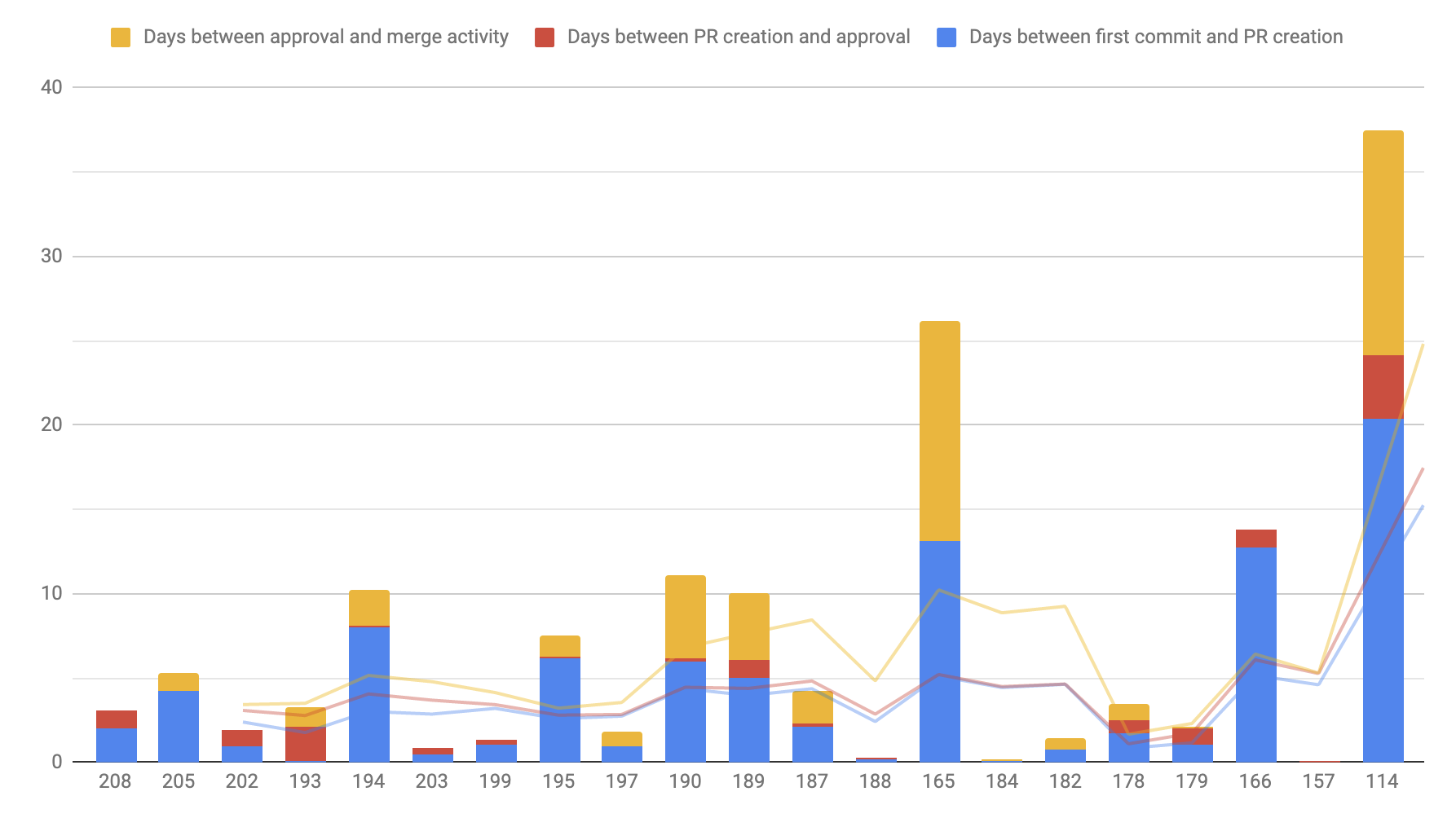bitbucket-pr-analysis v0.1.5
BitBucket PR Analysis
Provides utilities to study pull requests (PRs) merged in a Bitbucket repo.
Currently it supports using a Pearson correlation coefficient to help identify what bottlenecks a team is facing, and exporting some relevant PR measures as a CSV.

This data can be leveraged by engineering teams to identify bottlenecks on their flows, measure the progress since an experiment was executed,...
Getting Started
Prerequisites
Software requirements:
- NodeJS
- A BitBucket App password with "Read pull request" permission.
To ensure the dependencies are installed, execute:
npm installCreating your configuration file
Before executing the scripts, you'll have to setup your configuration file, which defines:
- What credentials to use to fetch data
- Which repositories to read
- How many pages of PRs to load
- Whether to filter the PRs to ensure we don't measure git flow special branches such as:
- Merge to master
- Release or hotfix branches being merged to develop or master
To do so, you'll need to define a config.json file at the root of the project with the following format:
{
"authorization": {
"username": "joseprl89",
"password": "my bitbucket app password"
},
"repositories": [
"myUser/myRepository",
"myUser/myOtherRepository",
"myOtherUser/yetAnotherRepository"
],
"pagesToLoad": 2,
"filterByGitFlow": true
}You can use the utility script to guide you through the creation of this file by executing:
npm run create-config --silentRunning the tests
Tests can be run using npm test.
Analysing your BitBucket repo
You can analyse a repo by running the NPM scripts available. Each analysis has its own section below.
Exporting measures to excel
Exports an xlsx file to enable to further analyse the data and visualise it in charts.
You can run the export using:
npm run --silent export-to-sheetCorrelations between measures
Analyses the correlation between metrics using the Pearson product-moment correlation coefficient (PPMCC) through the compute-pcorr node module.
This analysis is useful to identify which metric will have the highest impact on your overall performance once improved and to discover patterns that are hard to visualise.
You can run the analysis using:
npm run --silent correlationsAs a hypothetical example, the number of comments might correlate with your cycle time, so you should target reducing the need for those comments.
Interpreting the result
After analysing the last pull requests of your repo, the system will output a set of correlations between the time between first commit, to merging your PR.
The values can range from -1.0 to 1.0, where:
- 0 means the variable does not impact one way or another the time it takes to merge a PR, and therefore there's no need to optimise it.
- 1 means direct correlation. When the measure increases, so will the time between first commit and merge, thus you'll want to reduce this metric to reduce the time it takes to merge your code.
- -1 means inverse correlation. When the measure increases, it will cause a decrease of the time between first commit and merge, thus you'll want to reduce this metric to reduce the time it takes to merge your code.
As an example, these are results from a private repository:
Correlation between time to merge and Time between first commit and creation of the PR: 0.7894789362173071
Correlation between time to merge and Commit count: 0.5624755997810248
Correlation between time to merge and Time between approval and merge: 0.5611995438606215
Correlation between time to merge and Time between creation of the PR and approval: 0.5609924985817157
Correlation between time to merge and Merge commit count: 0.5534876138808782
Correlation between time to merge and Comment count: 0.4261628055496479
Correlation between time to merge and Activity count: 0.42079914430331505
Correlation between time to merge and Tasks used: NaN
Correlation between time to merge and Task count: NaNBased on these numbers, we should prioritise improvements on the following order:
- The time between first commit and creation of the PR.
- Number of commits in the PR.
- Time between approval and merge.
- Merge commit count
Caveats
PPMCC doesn't allow to easily compare discrete data (E.g. does the programming language impact the type?).
Therefore, we can't really measure things like "Would using language A, B or C correlate with the time to merge?"
Built With
- NodeJS
- Mocha - Test harness
- compute-pcorr - Pearson correlation implementation
- Excel4node - Excel exporter
- Node-fetch - REST API Client
Versioning
We use SemVer for versioning.
Relevant Links
- Pearson product-moment correlation coefficient (PPMCC) and compute-pcorr, The node module used as an implementation.
- Creating a BitBucket App password